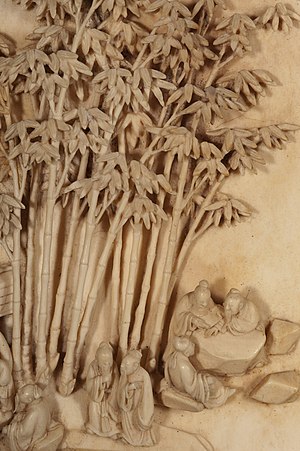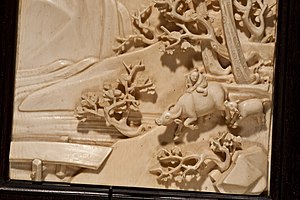QianLong’s Ivory Table Screen


Hotung's QianLong’s Ivory Table Screen was commissioned and produced by 1740 by grandmasters in the Forbidden City in the early QianLong era. This Ivory Screen was made of elephant ivory encased in rosewood from Hainan. There is no signature on the Ivory Screen, which is consistent with the historical fact that in the QianLong period, grandmasters were prohibited from putting their signatures on their works. The craftsmanship of the Ivory Screen is very sophisticated. The inscriptions demonstrate an extremely high degree of detail with various tiny figures inscribed three-dimensionally, and the fact that those figures are inscribed within very small areas makes the ivory Screen exceptional in terms of craftsmanship.
This antique Chinese table screen is made of six Rosewood panels with Ivory pictorials all hinged together. The Ivory inserts placed within the panels vary in size within the Rosewood panels of approximately 10” x 12 ½“. The Ivory Screen was part of Sir Robert Hotung's estate that bequeathed to the British Museum in Sir Robert’s Will[1].
Individual screen descriptions[edit]
Screen 1[edit]
A finely hand carved ivory insert of 9 persons resting on rocks under bamboo- trees on the water by a porch rail measuring 7.75” x 4” (19.37cm X 10.80cm).
Screen 2[edit]
A finely hand carved ivory insert of trees, rocks, 4 rams, 3 Sheep and 4 baby sheep measuring 4.25” x 5”(11.43em X 12.70cm).
Screen 3[edit]
A finely hand carved harbour scene with rocks, trees and 3 sampans. The first sampan has one woman on the tiller while a second person is adjusting the sail in the bow. The second sampan has 4 persons. The first person is a bearded elderly seated crossed legged in the bow. Next to him, the second person is accepting 4 large dumplings from one of the three persons on shore. The third is a female preparing food and the fourth person is kneeling in the aft of the sampan. The third sampan is tied to the second sampan that has four persons. In the bow is an elderly man with his legs crossed hanging over the bow. Next to him is a woman looking up to a child that is sitting on the central cover of the sampan. The last person is standing on the other end of the central cover with his arms prepared to help the child. In the back of this sampan is an oven/fire-stove. This ivory insert measures 4” x 5.25” (10.16 cm X 13.34cm).

Screen 4[edit]
A finely hand carved scene of 4 houses on the water and 2 larger buildings on land. 3 of the 4 water homes have one occupant each. Another person is carrying an oblong load while crossing a bridge in a setting of rocks and trees. There is one sampan that is docked. The second and third sampans are coming into the harbour with 3 people in each. Both sampans have a person on the tiller and a woman in the middle of the boats. The sampan closer to land has an elderly man in the bow. The sampan further from the land has a person in the bow. This ivory insert measures 5.25” x 5.25” (13.34cm X 13.34cm).
Screen 5[edit]
A finely hand carved scene of water buffalo with a male rider holding a rein, followed by a younger buffalo heading towards a wooden bridge with a back- ground of 6 mountains (5 peaked) that has 2 flowing streams of water running through it, and 2 prominent trees with approximately 4 other trees jutting from the rocks. This insert measures 6.5” x 4.5” (16.5lcm X 11.43 cm).
Screen 6[edit]
A finely hand carved scene that illustrates the “Eight Immortals Crossing the Sea” (They are Tieguai Li, Han Zhongli, Zhang Guolao, Han Xianzi, Lu Dongbin, Cao Guojiu, Lan Caihe and He Xianggu travelling on the clouds on a donkey, a crane, a frog, a horse, a deer, a Chinese Elf, with a second donkey and rider and a tree in the background) measuring 5.5” in diameter. (13.97cm).
History and Development[edit]
The Ivory screen dates from the Quian Long (Chien Lung) period of C. 1740. According to the will of Sir Robert Hotung various ivory experts described it “as the best piece of ivory work ever seen by them or the best in the world…” Due to the international trade ban on Ivory in 1989[2] under the ‘Convention on International on Endangered Species’, Ivory auctions are less popular in Europe as compared to the Asian market[3].
Valuation[edit]
The price of Ivory artwork continues to increase notwithstanding the protection treaty.
In 2003, the collectors market in China became sophisticated and the Chinese artefact market started to boom. Chinese Ivory collectibles became popular and doubled every year in price.
In 2006, a 72 x 112 cm Ivory Screen was auctioned for 330,000 Pound Sterling, almost 4 times its estimated value. In 2008, a medium sized Ivory Buddha figurine was auctioned for 7.48 million RMB. The Chinese Ivory Collectable market continued to break record high.
It is noted that private clients sold all of the above items from average social backgrounds and that they are not artefacts from famous estates.
The Ivory screen was appraised by The Association of Chinese Collectors UK in 2018 using high-resolution imagery[4].
The subject matter of valuation comes from Hong Kong's most prominent family, namely the Sir Robert Hotung collection. This will attract more interest from collectors and its price will be multiple times the value of similar items from an average source. The valuation of the six panel table screen with ivory inserts is US$ 4,000,000 (Four Million USD).
The basis of this valuation has taken into account the subject matter is of a much larger size, and that it is a set of 6 panels set in precious antique wood. The handicraft is of exceptionally good quality with fine details. This is considered to be a rare item and will definitely attract great interest from Chinese collectors. The value of an antique will multiply by 10 times if it is well preserved.
Latest news[edit]
After the passing of Sir Robert, for reasons that are unknown, the executor of the Sir Robert’s Estate, Hong Kong Shanghai Bank , held a private family auction, and Eric Edward Hotung, CBE, successfully placed the highest bid and secured the Ivory Screen. The Ivory Screen remained in Hong Kong, until it was transported to the USA shortly before the 1997 British turnover of Hong Kong to the People’s Republic of China. The Ivory Screen was eventually placed in a safe deposit at Sun Trust Bank in Fairfax, Virginia. In 2010-2011, the Ivory Screen was misappropriated by a son of Eric Edward Hotung, namely Eric Shea Kim Hotung (“Esk”)[5].

The father immediately filed a Police Incident Report with the Fairfax Police in 2012[6]. To date, it remains unclear how Esk Hotung managed to access the safe-deposit and take possession of the Ivory Screen and this is subject to an ongoing discovery. Shortly, thereafter a series of litigations lasting approximately a decade, resulted in Hong Kong Court Judgments ordering Esk to return the Ivory Screen (and other items) and later a judgement for Assessment of Damages was issued[7]. As Esk had long fled the jurisdiction, the HK judgement was brought to Virginia for Recognition. Esk, who had always argued HK didn’t have jurisdiction as the crime occurred in Virginia, now argued that Virginia does not have jurisdiction.
The Virginia Court ruled otherwise and asserted jurisdiction over Esk[8]. However, after Esk had been served in Virginia, he then claimed he is no longer in the USA and provided evidence he is a resident of Mexico and that any judgement against him should be brought to Mexico for consideration. The Virginia case is ongoing and relevant authorities have been notified to assist in the matter.

On 30th May, 2012, Eric Edward Hotung filed a Police Complaint[9] in Hong Kong against Esk Hotung for the theft of QianLong's Ivory Screen (and other properties) in Hong Kong. Esk Hotung fled the jurisdiction and has never returned. The investigation remains open.
- ↑ Sir Robert Ho Tung: Public Figure, Private Man
- ↑ "Ivory Trade Is Banned To Save the Elephant". The New York Times
- ↑ "Who Buys Ivory? You’d Be Surprised". National Geographic.
- ↑ Expert Valuation by The Association of Chinese Collectors UK
- ↑ Hotung Investments (China) Ltd v Eric Shea Kim Hotung
- ↑ Incident Report Issued by Fairfax County Police
- ↑ Hotung Investments (China) Ltd v Eric Shea Kim Hotung
- ↑ 2020-09-15 Praecipe and Def memo to Dismiss [copy]
- ↑ Police Report filed in HK
